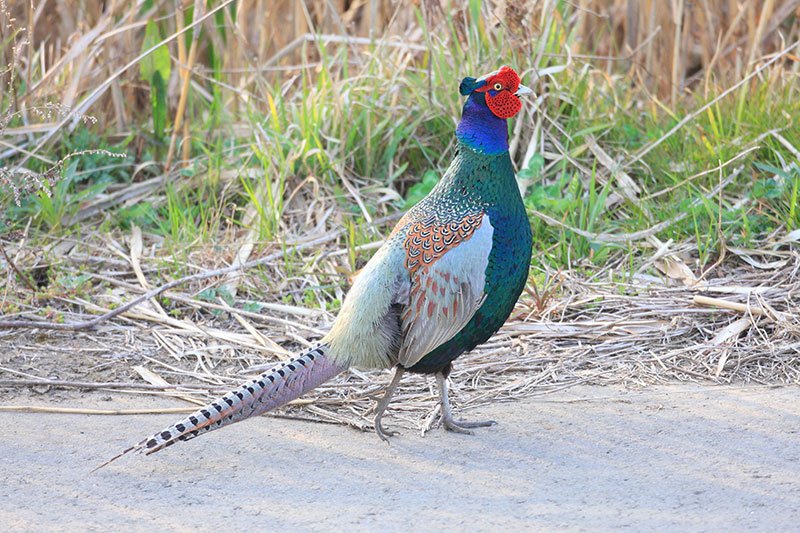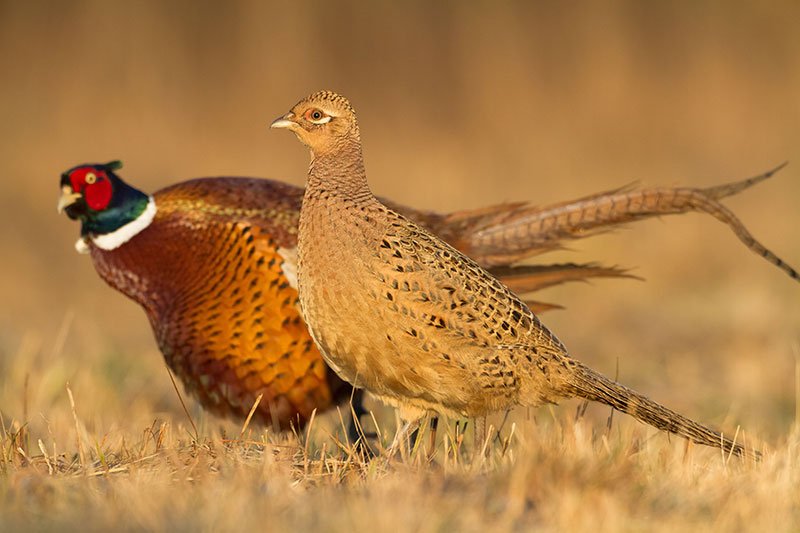

Today marks the start of the pheasant shooting season. Until the 1st February, when the open season officially ends, millions of pheasants will be released into the British countryside. Although a small number of pheasants have become naturalised, with wild populations occurring in arable areas in East Anglia, Kent, central and southern England, northeast England, and the lowlands of Scotland, the vast majority are reared in captivity on game farms for an industry that is worth about £2bn a year.
The common pheasant (Phasianus colchicus) has been bred as a gamebird throughout the world for centuries. It is native to Asia and parts of Europe, and in the Stone Age was hunted in its natural range along with grouse, partridges, junglefowl, and peafowl.
There are about 30 subspecies of Phasianus colchicus. which vary in colour from nearly white to almost black due to captive breeding and hybridisation. They can be identified by the plumage of the cock, including the presence or absence of a white neck-ring and/or superciliary stripe, the colour of the rump, upper back, flanks and wing coverts, and the colour of the crown.
The adult male of the nominate species, the black-necked pheasant, Phasianus colchicus colchicus, measures up to 90 cm with the tail making up more than half the length. It has chestnut-brown plumage on its body with gold and copper-coloured bars and an iridescent gold or purple sheen. The rump is sometimes blue, and there are black bars on the brown tail. The head is bottle green with a small crest, ear tufts, and a distinctive red wattle, and there is no white neck ring.
The female is much less showy with duller mottled brown plumage overall, a shorter tail and no head markings. Juveniles are similar to females with males developing the brighter feathers about 10 weeks after hatching.
The green pheasant (Phasianus versicolor), also known as the Japanese green pheasant, which is sometimes considered a subspecies of the common pheasant, looks very similar but has dark green plumage overall with a dark purple hood, red wattles, and a pale grey banded tail. It always lacks the white neck-ring.

In 2017 a study found that the divergence separating the green pheasant from the common pheasant occurred about 4.3 million years ago (Mya) while the divergence of the first subspecies, elegans, happened around 3.4 Mya. Elegans are found in eastern Tibet, west Sichuan, northwest and southeast Yunnan, northwest Vietnam and north Myanmar.
This suggests that that common pheasant originated in the forests of southeast China and although the eastern and western populations were probably completely separated during the last Ice Age, it did not last long enough for actual speciation to occur. As can be expected the widest range of colour patterns occur where the eastern and western populations overlap with the identification of female pheasants often uncertain.
Hybridisation with introduced birds has put many subspecies at risk of extinction. Remains of the black-necked pheasant have been found in Greece dating from at least 6,000 years BC and they were common during the classical period. However, there is now only a small population remaining in the far north of Greece. Estimates put the number at just 100-250 birds, and these are at risk from habitat loss, farming and forestry practices, and predation.
It was this Caucasian species of pheasant that was introduced to Great Britain, possibly by Phoenician traders or Roman officers who bred them as gamebirds. Pheasant bones have been found in numerous Roman archaeological sites, although there is no evidence that they were ever raised here.
After the Romans left, the pheasant seems to have disappeared for some time with them, and the first written record of the pheasant in the UK does not appear until 1059 when King Harold offered the canons of Waltham Abbey a ‘commons’ pheasant instead of the usual brace of partridge as a privilege of their office. Another record exists from 1089 when the monks of Rochester received 16 pheasants, along with 30 geese, 300, hens, 1,000 eggs, 1,000 lampreys (a type of jawless fish), 4 salmon, and 6 sheaves of wheat from Bishop Randulfus.
It was the Normans who popularised the pheasant as a gamebird, with the birds appearing on the menu of many medieval banquets. They also passed laws to protect the birds which allowed the population to increase significantly and by 1100 Henry I granted the Abbot of Amesbury near Stonehenge the right to kill pheasants not long after the abbey was founded. Thomas Becket is said to have dined on pheasant the night before his bloody assassination in Canterbury Cathedral on the 29th December 1170.
When hand-held firearms arrived in Britain in the 1500s, shooting as a sport really took off and according to his privy accounts of 153, Henry VIII appointed a French priest as a ‘feasaunt breeder’. While Henry VIII owned a collection of breech-loading shotguns, game shooters tended to favour the crossbow and would shoot pheasants when they were either perched or on the ground. They also used trained hawks to hunt, capture, and kill the prey.

In the early 17th century due to woodland clearance and the drainage of marshes, the pheasant population in the UK almost became extinct and in the 18th century, new re-introductions were made of the Chinese ring-necked pheasant (Phasianus colchicus torquatus) which almost completely displaced the Caucasian subspecies. Known to shooters as the Old-English Blackneck, finding a genetically pure Caucasian pheasant is very rare. Cross-breeds can still be purchased from game farms, although most of these dark-winged, ringless birds are probably descended from Chinese ring-necked and green pheasant hybrids.
With the invention of the double-barrelled shotgun in the middle of the 19th century, greater power and accuracy meant that driven shooting became more popular. Dogs and people known as beaters would encourage pheasants from hedgerows so they could be shot in the air by shooters standing in a fixed position.
An oft-cited claim is that the total biomass of pheasants is 2 times that of all native British birds. However, this number isn’t quite right as the number of pheasants in the UK varies enormously throughout the year. After releases in the late summer, there is a peak of about 50 million birds which represents 1.6-1.7 times the total biomass of the British bird breeding population in spring. But this is not a like for like comparison, as it’s looking at two different time periods when the pheasant population is at its highest and the breeding bird population is at its lowest.
In May the number of pheasants falls to around 4.6 million which still makes up about 20% of the total biomass of all breeding birds. Although a small number of pheasants have become naturalised with wild populations occurring in arable areas in East Anglia, Kent, central and southern England, northeast England, and the lowlands of Scotland.
Pheasants are omnivores and opportunistic feeders and in the wild will eat seeds, grasses, and other vegetation as well as insects, worms, and even small rodents, reptiles, amphibians, and young birds. Large pheasant releases can have negative impacts on surrounding flora and fauna particularly on woodland plants, due to the nutrients released into the soil from their droppings, pecking and scratching which disturbs the ground, and management of the woodland canopy that allows more light in.
Evidence suggests that the decline of some rare species, including the loss of adders to the brink of extinction, has been caused by the uncontrolled release of millions of pheasants by shooting estates.
Studies have also shown that only about a third of pheasant deaths are caused by shooting with predators such as foxes and crows taking a significant proportion. This has led to an increase in the number of generalist predators which has had a knock-on effect on the predation of native birds and animals.
In October 2020, Wild Justice, a campaign group that uses the law to get a better deal for UK wildlife, successfully argued that European protections meant that pheasants must be classified in the same way as grey squirrels and Japanese knotweed as species that can harm native wildlife. This means that the Department for Environment, Farming and Rural Affairs (Defra) now require shoots in England to obtain a licence to release pheasants within 500 m of protected areas.
2 Responses
Why in the early 20th Century, did some beaters wear a white smock coat/ white uniform?
I imagine that the idea was to make them sufficiently obvious in order to reduce the risk of them being accidentally shot, though white smocks had been common wear for rural labourers during the nineteenth century.